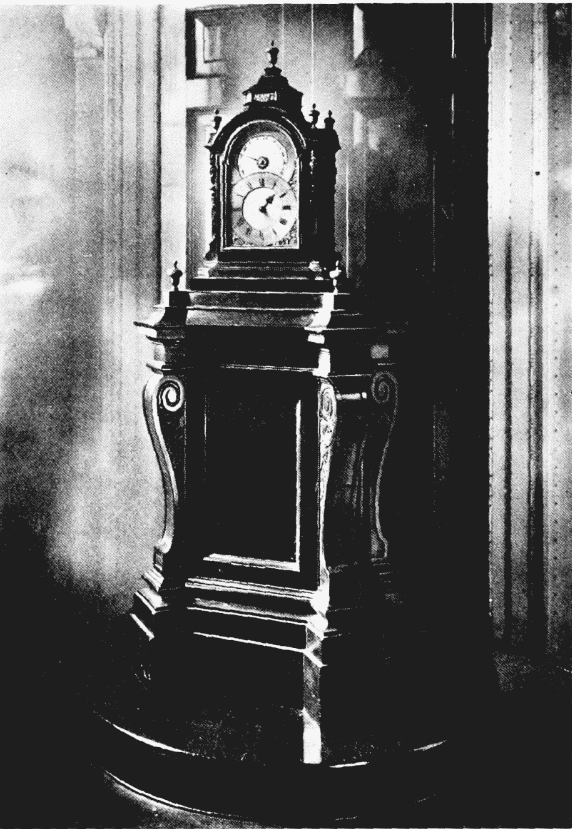The Charles Clay Musical Clocks - Repost. 2.
Catalogue entry from an unknown auction sale -
The Clay Astronomical Clock in the Board Room Treasury Buildings, Whitehall, Westminster.
1739. Whitehall Treasury Chambers. Mr Lowther is to pay Mr
Clay the clock maker £13-2s-0d in full of all his demands for looking after and
repairing the Treasury clock 1721 March 25th to 1725 Aug.18th or any time
after. (Calendar of Treasury Books Vol.4). - BHO.
A Musical Clock by Charles Clay.
These pages below from Old Clocks and Watches and their Makers, FJ Britten, 1904. Second Edition.
https://archive.org/stream/oldclockswatches00brit#page/n7/mode/2up
see also - https://www.jstor.org/stable/738126?seq=1&refreqid=excelsior%3A4a2c27228ae398e8893f5d534ee9ee1c#page_scan_tab_contents
The Clock is 98 tall cms x 81 cms wide.
Provenance -
Believed to have been taken to Castletown by and Katherine Conolly, nee Conyngham (d.1752), the wife of the Speaker of the Irish house of Commons William Connolly (1662 - 1729)
William Conolly was at the time the richest man in Ireland
by descent to Major William Francis Conolly-Carew
Purchased by Desmond Guiness in 1966.
Desmond Guiness had purchased the house in 1967 from a Major Wilson who had bought the house and its collection in 1965.
Bought by the Castletown Foundation in 1975.
The chimes not currently functioning.
Information from Castletown Decorative Arts pub 2011
Office of Public Works Ireland
Very kindly supplied by Celine of the Guides reception at Castletown.
............................
The Temple of The Four Grand Monarchies of the World.
1738. March 2nd. On Thursday last Mr Clay entertained their
Royal Highness the Prince and Princess of Wales with his musical machine at
their Royal Highness house in St James Square and after having heard the
beautiful strains of music was graciously pleased. (Stamford Mercury
Newspaper).
This clock was finished by John Pyke, clockmaker to Frederick, Prince of Wales, and its elaborate case included reliefs in silver, based on models by Rysbrack and bronzes representing the seated figures of the four Grand Monarchies modelled by the French London-based sculptor Louis Francois Roubiliac (1702-62). The clock was surmounted by Roubiliac's figures of Hercules and Atlas supporting the globe.
In December 1743 it was available to view at John Pyke's premises at the corner of Brownlow Street, facing Bedford Row near Gray's Inn. It apparently cost more than £4,500.
The case was a 'noble Structure, a regular Piece of Architecture in the Corinthian Order ... made of fine Ebony, with Mouldings of Brass; its Columns and Entablatures are also of Brass adorn'd with Modilions, Capitals, Bases and other ornaments of Silver in the most elegant Taste. It is supported with a Pedestal of circular Form, made of Curious Wood, with Brass Mouldings, and adorn'd with other Ornaments of Brass, upon which it turns round at Pleasure for the greater Conveniency of the Spectators'.
This clock was also later acquired for Augusta, widow of Frederick, Prince of Wales.
The long delay between the completion of the clock and its acquisition for the Royal Collection explains Clay's frustration with the challenge of marketing his musical creations.
Three days before his death, he 'order'd a Musical Machine, which had cost him about 20 Years Time, and upwards of £2000 to bring to perfection, to be beat to Pieces, and entirely destroy'd to prevent the Expense of the Time and Money of any one who should attempt to finish it after his death'.
It seems unlikely that Mrs Clay carried out her husband's death-bed wishes.
The Temple of the Four Grand Monarchies of the World.
1740.
Commenced by Charles Clay and completed by John Pyke.
in the Rotunda at Kensington Palace.
Acquired by Princess Augusta after 1743.
https://www.royalcollection.org.uk/collection/search#/54/collection/1418/floor-standing-clock
Excerpt below from Tessa Murdoch, Apollo, November 2013
https://www.thefreelibrary.com/Time's+melody.-a0351262546
Bronze mounts by Louis Francois Roubiliac.
All photographs above from the Royal Collection.
The text below is lifted in its entirety from the Royal Collection website for which I can make no apologies. I coudn't do better. I have only created the paragraphs to make this information slightly more digestible.
see - https://www.royalcollection.org.uk/collection/search#/54/collection/1418/floor-standing-clock




















No comments:
Post a Comment